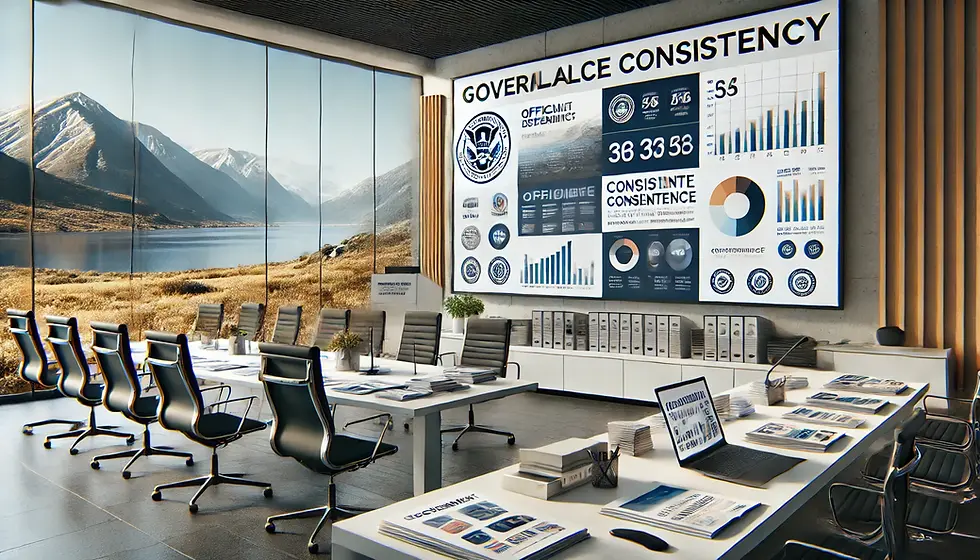How to Engage Evaluators During an Oral Proposal Presentation
- Patriot Data Graphics

- Jun 11
- 5 min read

A proposal presentation is more than just a verbal summary of your written submission, it’s an opportunity to connect with evaluators, clarify key points, and showcase your expertise.
However, many presenters fall into the trap of delivering monotone, text-heavy, or uninspiring presentations, causing evaluators to lose interest and miss critical details.
The key to a successful oral proposal presentation is engagement. This article explores proven techniques to capture and maintain evaluator attention, ensuring your message resonates and leaves a lasting impression.
1. Understand What Evaluators Want
Government and corporate proposal evaluators follow a structured scoring process. They are not looking for flashy sales pitches, they want clear, well-organized information that helps them make a confident decision.
Evaluators prioritize:
Compliance and clarity – Does your presentation align with the RFP criteria?
Technical expertise – Does your team demonstrate a deep understanding of the solution?
Confidence and credibility – Do presenters speak clearly, professionally, and knowledgeably?
Efficiency and engagement – Is the presentation easy to follow and engaging without being too long?
Understanding these expectations allows you to tailor your delivery to what matters most.
2. Open with a Strong and Engaging Introduction
Evaluators typically form first impressions within the first 30 seconds. A strong opening immediately sets the tone and captures their attention.
Key Elements of an Engaging Introduction
A warm and confident greeting – Establish professionalism and approachability.
Brief team introductions – Highlight key qualifications, but avoid lengthy bios.
A compelling hook – Share a quick fact, statistic, or challenge that resonates with evaluators.
A clear agenda – Outline what will be covered in the presentation.
Example Opening Statement:
"Good morning, and thank you for this opportunity. I’m [Your Name], and our team at [Company Name] is excited to present how our solution will enhance [Agency/Company’s] operations while ensuring cost efficiency and compliance. Today, we’ll walk you through our approach, highlight key differentiators, and answer any questions you may have."
This introduction immediately establishes confidence, sets expectations, and engages evaluators.
3. Make Your Slides Engaging, Not Overwhelming
Your slides should enhance your spoken message, not replace it. Many presenters make the mistake of overloading slides with text, causing evaluators to read instead of listening.
Slide Best Practices for Engagement
Use minimal text – Stick to bullet points with key takeaways.
Incorporate visuals – Use diagrams, process flows, and comparison tables instead of text-heavy explanations.
Maintain consistent branding – Use professional fonts, colors, and slide templates.
Follow the 10-20-30 rule – No more than 10 slides, 20 minutes of presentation time, and a minimum 30-point font size.
Before & After Example:
Before: A dense slide with a full paragraph explaining a process.
After: A simple three-step visual diagram with key takeaways.
By making slides clear, visually appealing, and structured, evaluators will stay engaged and absorb information more effectively.
4. Use Storytelling to Make Your Solution Memorable
Stories engage the human brain 22 times more effectively than data alone (Haven, 2007). Instead of simply listing facts, use storytelling to bring your solution to life.
How to Incorporate Storytelling in Proposal Presentations
Use real-world examples – Share a brief case study or success story from a past contract.
Describe a challenge and resolution – Walk through a “before and after” scenario that highlights the impact of your solution.
Make it personal – If applicable, use testimonials or firsthand experiences from project leads.
Example Storytelling Approach:
"Before implementing our solution, [Agency Name] was struggling with inefficiencies that delayed processing times by 30%. After deployment, our system reduced delays to less than 5%, saving the agency millions annually. We will apply this same methodology to your project to ensure similar success."
By weaving in relevant, relatable stories, evaluators will connect emotionally with your solution, making it more memorable.
5. Use Audience Interaction Techniques
An engaged evaluator is more likely to retain key details and score your proposal favorably. Instead of delivering a one-way lecture, encourage participation.
Ways to Increase Audience Interaction
Ask rhetorical questions – “What if you could reduce response times by 40%?”
Invite participation – “Would you like a brief demonstration of how this feature works?”
Encourage nodding or agreement – “We know compliance is critical—does this align with your current priorities?”
Use eye contact and body language – Engage evaluators visually, whether presenting in person or virtually.
Interactive elements keep the audience involved and make your presentation feel more like a conversation.
6. Handle Questions with Confidence and Precision
The Q&A session is your chance to reinforce key points and demonstrate expertise.
Evaluators will often ask detailed, scenario-based questions to gauge your readiness to execute the contract.
Strategies for Answering Questions Effectively
Anticipate tough questions – Review the RFP and prepare responses in advance.
Assign the right team members – Ensure SMEs (Subject Matter Experts) are ready to answer technical inquiries.
Answer concisely and directly – Avoid rambling; stay focused and confident.
Support responses with data – Whenever possible, use metrics, facts, and past performance to strengthen credibility.
Example Response to a Tough Question:
Question: “How does your team plan to manage potential project delays?”
Answer: “We mitigate delays through a three-phase implementation plan, allowing us to identify risks early and adjust resources accordingly. For example, in a previous contract of similar scope, we faced unexpected vendor delays but avoided project setbacks by proactively reallocating team members. Our approach ensures on-time delivery and compliance with your project schedule.”
A well-handled Q&A session instills confidence in your team’s capabilities.
7. Close with a Powerful and Persuasive Ending
Your closing statement should reinforce your key points, express appreciation, and leave a lasting impression.
Key Elements of a Strong Closing
Summarize your solution’s value – Reinforce the three biggest takeaways.
Express enthusiasm and confidence – Show your commitment to executing the project.
Outline next steps – Let evaluators know what comes next in the selection process.
Example Closing Statement:
"In summary, our team is prepared to deliver a solution that enhances efficiency, reduces costs, and ensures full compliance. We appreciate the opportunity to present today and look forward to the next steps in the selection process. Thank you."
A strong closing ensures that evaluators leave with a positive impression of your team and solution.
Conclusion: Engagement Drives Winning Presentations
An engaging proposal presentation is clear, structured, and interactive. By focusing on storytelling, audience participation, strong visuals, and confident delivery, you increase the likelihood of resonating with evaluators and securing the contract.
Action Tip:
Before your next presentation, ask yourself:
· Does my opening capture attention?
· Are my slides clear and visually engaging?
· Am I using storytelling to reinforce key points?
· Is my team prepared for tough questions?
By mastering these techniques, you can transform your proposal presentation into a winning opportunity.
References
Haven, K. (2007). Story Proof: The Science Behind the Startling Power of Story. Libraries Unlimited.
Duarte, N. (2012). HBR Guide to Persuasive Presentations. Harvard Business Review Press.
U.S. General Services Administration (2022). Best Practices for Federal Proposal Presentations.




Comments